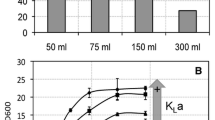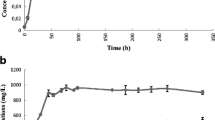Abstract
The present study addresses growth parameters and physiological and biochemical characteristics of the aerobic CO-oxidizing carboxydobacterium Seliberia carboxydohydrogena Z-1062. Poly(3-hydroxybutyrate) yields were investigated in experiments with limiting concentrations of mineral nutrients (nitrogen or sulfur or nitrogen and sulfur) in batch culture of S. carboxydohydrogena Z-1062 grown on gas mixtures consisting of CO2, O2, H2, and CO. CO concentrations of 10, 20, and 30 % v/v did not affect polymer synthesis, whose content after 56-h cultivation under limiting concentrations of nitrogen and sulfur was 52.6–62.8 % of biomass weight at a productivity of 0.13–0.22 g/L h. The inhibitory effect of CO on cell concentration was revealed at CO concentration of 30 % v/v. That also caused a decrease in substrate (H2 and O2) use efficiency. Thus, this carboxydobacterium can be regarded as a potential producer of polyhydroxyalkanoates from industrial hydrogenous sources.





Similar content being viewed by others
References
Sudesh K, Abe H, Doi Y (2000) Synthesis, structure and properties of polyhydroxyalkanoates: biological polyesters. Prog Polym Sci 25:1503–1555
Choi J, Lee SY (1999) Factors affecting the economics of polyhydroxyalkanoate production by bacterial fermentation. Appl Microbiol Biotechnol 51:13–21
Sudesh K, Bhubalan K, Chuah JA, Kek YK, Kamilah H, Sridewi N, Lee YF (2011) Synthesis of polyhydroxyalkanoates from palm oil and some new applications. Appl Microbiol Biotechnol 89:1373–1386. doi:10.1007/s00253-011-3098-5
Arcos-Hernandez MV, Pratt S, Laycock B, Johansson P, Werker A, Lant PA (2013) Waste activated sludge as biomass for production of commercial-grade polyhydroxyalkanoates (PHA). Waste Biomass Valorization 4:117–127. doi:10.1007/s12649-012-9165-2
Nikodinovic-Runic J, Guzik M, Kenny ST, Babu R, Werker A, O’Connor KE (2013) Carbon-rich wastes as feedstocks for biodegradable polymer (polyhydroxyalkanoates) production using bacteria. Adv Appl Microbiol 84:141–200. doi:10.1016/B978-0-12-407673-0.00004-7
Durner R, Witholt B, Egli T (2000) Accumulation of poly[(R)-3-hydroxyalkanoates] in Pseudomonas oleovorans during growth with octanoate in continuous culture at different dilution rates. Appl Environ Microbiol 66:3408–3422
Lee IY, Kim CH, Yeon BK, Hong WK, Choi ES, Rhee SK, Park YH, Sung DH, Baek WH (1997) High production of d-β-hydroxyisobutyric acid from methacrylic acid by Candida rugosa and its mutant. Bioprocess Eng 16:247–252
Maskow T, Babel W (2000) Calorimetrically recognized maximum yield of poly-3-hydroxybutyrate (PHB) continuously synthesized from toxic substrates. J Biotechnol 77:247–253
Khosravi-Darani K, Mokhtari ZB, Amai T, Tanaka K (2013) Microbial production of poly(hydroxybutyrate) from C1 carbon sources. Appl Microbiol Biotechnol 97:1407–1424. doi:10.1007/s00253-012-4649-0
Koller M, Atlić A, Dias M, Reiterer A, Braunegg G (2010) Microbial PHA production from waste raw materials. In: Chen G-Q, Steinbüchel A (eds) Plastics from bacteria—natural functions and applications. Springer, Heidelberg, pp 86–114
Tanaka K, Ishizaki A, Kanamuru T, Kawano T (1995) Production of poly(d-3-hydroxybutyrate) rom CO2, H2, and O2 by high cell density autotrophic cultivation of Alcaligenes eutrophus. Biotechnol Bioeng 45:268–275
Volova TG (2009) Hydrogen-based biosynthesis. Nova Science Publisher Inc., New York
Lee SY (1996) Bacterial polyhydroxyalkanoates. Biotechnol Bioeng 49:1–14
Ishizaki A, Tanaka K, Taga N (2001) Microbial production of poly-d-3-hydroxybutyrate from CO2. Appl Microbiol Biotechnol 57:6–12. doi:10.1007/s002530100775
Volova T, Kiselev E, Shishatskaya E, Zhila N, Boyandin A, Syrvacheva D, Vinogradova O, Kalacheva G, Vasiliev A, Peterson I (2013) Cell growth and PHA accumulation from CO2 and H2 of a hydrogen-oxidizing bacterium, Cupriavidus eutrophus B-10646. Bioresour Technol 146:215–222. doi:10.1016/j.biortech.2013.07.070
Do YS, Smeenk J, Broer KM, Kisting CJ, Brown R, Heindel TJ, Bobik TA, DiSpirito AA (2007) Growth of Rhodospirillum rubrum on synthesis gas: conversion of CO to H2 and poly-β-hydroxyalkanoate. Biotechnol Bioeng 97:279–286. doi:10.1002/bit.21226
Tanaka K, Miyawaki K, Yamaguchi A, Khosravi-Darani K, Matsusaki H (2011) Cell growth and P(3HB) accumulation from CO2 of a carbon monoxide-tolerant hydrogen-oxidizing bacterium, Ideonella sp. O-1. Appl Microbial Biotechnol 92:1161–1169. doi:10.1007/s00253-011-3420-2
Przybylski D, Rohwerder T, Dilßner C, Maskow T, Harms H, Müller RH (2015) Exploiting mixtures of H2, CO2, and O2 or improved production of methacrylate precursor 2-hydroxyisobutyric acid by engineered Cupriavidus necator strains. Appl Microbiol Biotechnol 99:2131–2145. doi:10.1007/s00253-014-6266-6
Zavarzin GA (1978) Hydrogen bacteria and carboxydobacteria. Nauka, Moscow (In Russian)
Gruzinsky IV, Gogotov IN, Bechina EM, Semenov YV (1977) Dehydrogenase activity of hydrogen-oxidizing bacteria Alcaligenes eutrophus. Microbiology (Mikrobiologiya) 46:625–630
Volova TG, Kalacheva GS, Altukhova OV (2002) Autotorophic synthesis of polyhydroxyalkanoates by the bacteria Ralstonia eutropha in the presence of carbon monoxide. Appl Microbiol Biotechnol 58:675–678. doi:10.1007/s00253-002-0941-8
Volova TG, Yangolov OV, Kahanov YG, Konovalov NM (1996) Sposob kultivirovaniya vodorodokislyayuschih bacterii (A technique of cultivation of hydrogen-oxidizing bacteria). RF Patent No 2051962. (In Russian)
Volova TG, Kalacheva GS, Gitelson II, Kuznecov BN, Schipko AM, Shabanov VF (2003) Sposob polucheniya polimera—β-oksimaslyanoi kisloti (A technique of producing a polymer—β-oxybutyric acid). RF Patent No 2207375. (In Russian)
Volova TG, Shishatskaya EI (2012) Shtamm bakterii VKPM B-10646—produtsent poligidroksialkanoatov I sposob ikh polucheniya (Bacterial strain VKPM B-10646—a producer of polyhydroxyalkanoates and a method of their production). RF Patent No. 2439143. (In Russian)
Meyer O, Schlegel HG (1983) Biology of aerobic carbon monoxide-oxidizing bacteria. Ann Rev Microbiol 37:277–310
Volova TG, Terskov IA, Trubachev IN, Sidko FY (1982) Growth and biochemical composition of carboxydobacteria. Izvestia Akademii Nauk SSSR. Seriya biologicheskaya 923–931. (In Russian)
Volova TG, Kalacheva GS, Kasaeva GE, Tereshkova GM (1986) The influence of the conditions of the gas supply on the growth and metabolism of carboxydobacteria. Microbiology (Mikrobiologiya) 55:938–943 (In Russian)
Volova TG, Guseinov OA, Kalacheva GS, Medvedeva SE, Puzyr AP (1993) Effect of monoxide on metabolism and ultrastructure af carboxydobacteria. World J Microbiol Biotechnol 9:160–163
Volova TG, Kalacheva GS, Trubachev IN, Filippova VK (1988) Study of the physiological and biochemical characteristics of carboxydobacteria under nutrient limitation. Microbiology (Mikrobiologiya) 57:61–64 (In Russian)
Volova TG, Kalacheva GS, Konstantinova VM (1994) Accumulation of polyoxybutyrate by aerobic CO-oxidizing bacteria Seliberia carboxydohydrogena. Microbiology (Mikrobiologiya) 63:211–216 (In Russian)
Volova TG, Kalacheva GS, Plotnikov VF (1998) Biosynthesis of heteropolymeric polyhydroxyalkanoates by chemolithoautotrophic bacteria. Microbiology (Mikrobiologiya) 67:420–424
Spirin AS (1958) Spectrophotometric determination of the total amount of nucleic acids. Biochemistry (Biokimiya) 23:656–660 (In Russian)
Kalacheva GS, Volova TG (2007) Fatty acid composition of Wautersia eutropha lipids under conditions of active polyhydroxyalkanoates synthesis. Microbiology (Mikrobiologiya) 76:608–614. doi:10.1134/s00262611707050049
Volova TG, Kalacheva GS, Kasaeva GE, Tereshkova GM (1987) The influence of the physical and chemical conditions of the medium on the growth and biochemical composition of carboxydobacteria. Microbiology (Mikrobiologiya) 56:973–978 (In Russian)
Volova TG, Zhila NO, Kalacheva GS, Brigham CJ, Sinskey AJ (2013) Effects of intracellular poly(3-hydroxybutyrate) reserves on physiological-biochemical properties and growth of Ralstonia eutropha. Res Microbiol 164:164–171. doi:10.1016/j.resmic.2012.10.008
Chen G-Q (2009) A microbial polyhydroxyalkanoates (PHA) based bio- and materials industry. Chem Soc Res 38:2434–2446. doi:10.1039/b812677c
Acknowledgments
The research was supported by the state budget allocated to the fundamental research at the Russian Academy of Sciences (project No 01201351505).
Author information
Authors and Affiliations
Corresponding author
Rights and permissions
About this article
Cite this article
Volova, T., Zhila, N. & Shishatskaya, E. Synthesis of poly(3-hydroxybutyrate) by the autotrophic CO-oxidizing bacterium Seliberia carboxydohydrogena Z-1062. J Ind Microbiol Biotechnol 42, 1377–1387 (2015). https://doi.org/10.1007/s10295-015-1659-9
Received:
Accepted:
Published:
Issue Date:
DOI: https://doi.org/10.1007/s10295-015-1659-9




